Case Report: Application of Public Health for the Uninsured - DNP-825
VerifiedAdded on 2022/11/16
|13
|3822
|125
Case Study
AI Summary
This case report analyzes the impact of the Affordable Care Act (ACA) on healthcare access in the United States, focusing on the rising number of uninsured individuals since 2017. It reviews the IOM and Kaiser Commission reports, highlighting that despite the ACA's initial success in expanding coverage, millions remain uninsured. The report identifies key factors contributing to this issue, such as affordability, lack of awareness, and ineligibility for certain populations. A literature review supports the analysis, detailing the demographics of the uninsured and the consequences of lacking healthcare access. The case study then applies a theoretical public health and management framework, specifically the transtheoretical model, to propose evidence-based interventions aimed at increasing awareness and improving healthcare access for the uninsured. The discussion section emphasizes the importance of addressing the issue to align with national healthcare goals, and the report concludes by summarizing the key findings and advocating for policy changes to support the ACA's objectives. The assignment is a case study that explores the challenges of healthcare access in the US, focusing on the uninsured population and the Affordable Care Act. It explores the application of public health concepts to address this issue and improve healthcare access, offering students a valuable resource for their studies, available on Desklib.
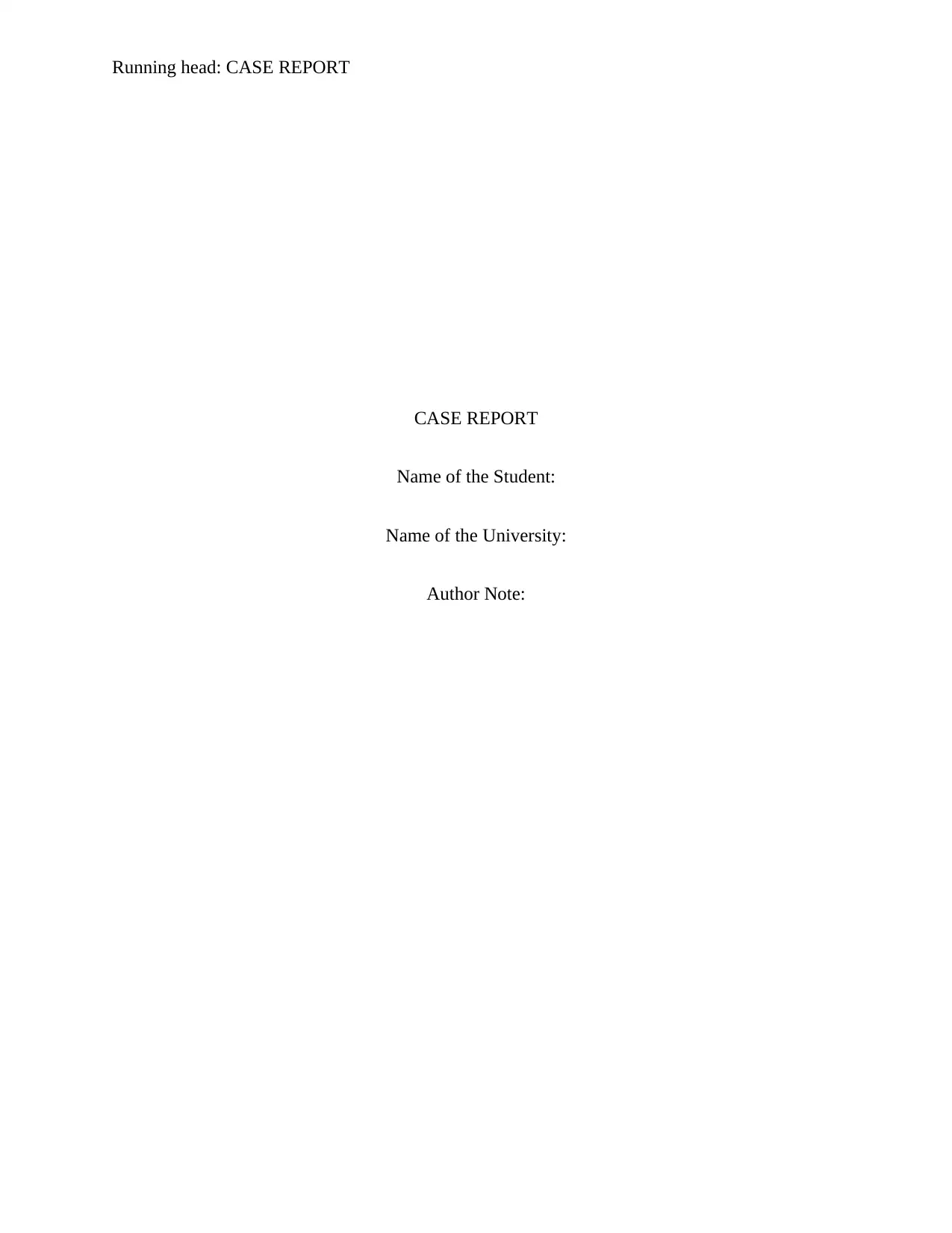
Running head: CASE REPORT
CASE REPORT
Name of the Student:
Name of the University:
Author Note:
CASE REPORT
Name of the Student:
Name of the University:
Author Note:
Paraphrase This Document
Need a fresh take? Get an instant paraphrase of this document with our AI Paraphraser
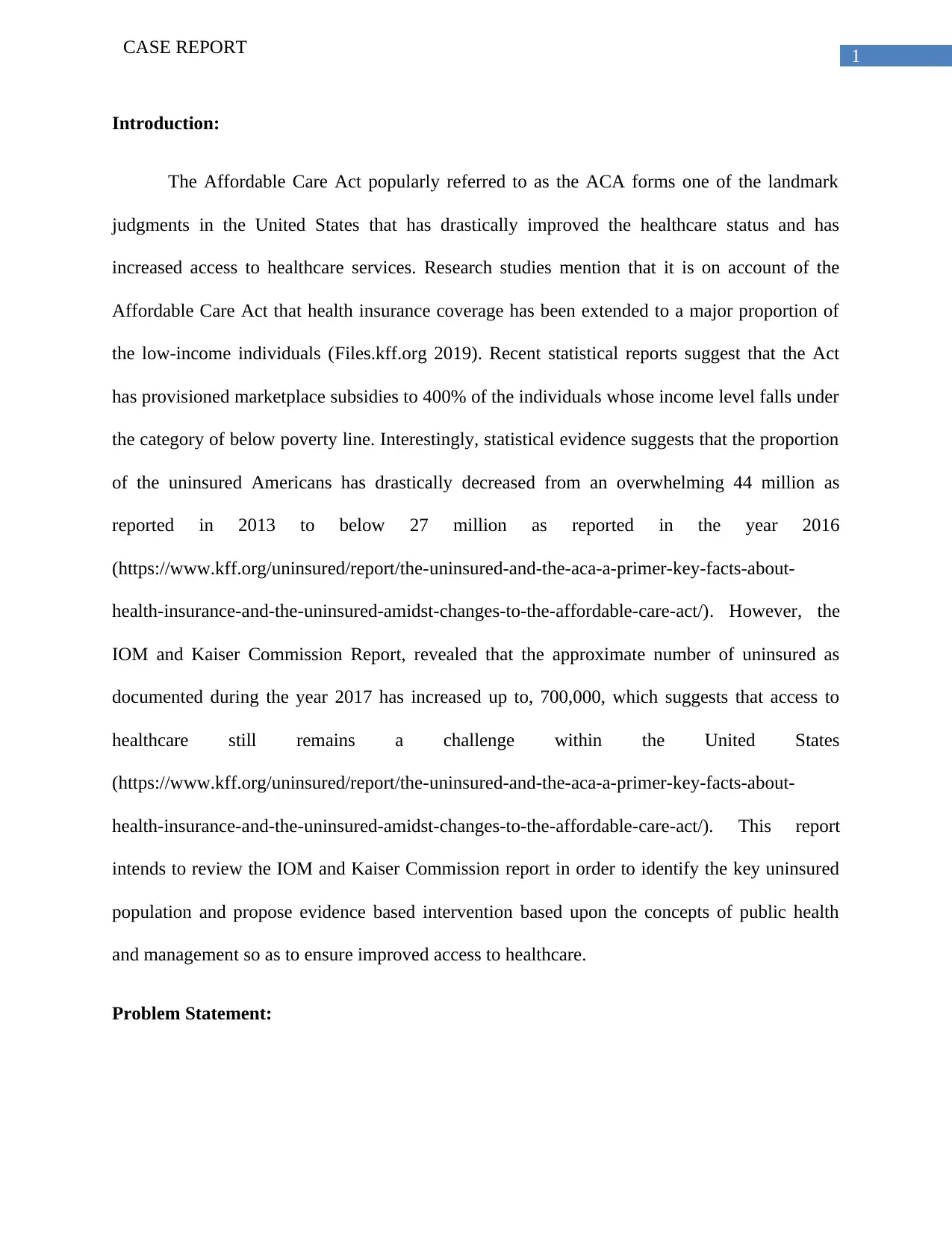
1CASE REPORT
Introduction:
The Affordable Care Act popularly referred to as the ACA forms one of the landmark
judgments in the United States that has drastically improved the healthcare status and has
increased access to healthcare services. Research studies mention that it is on account of the
Affordable Care Act that health insurance coverage has been extended to a major proportion of
the low-income individuals (Files.kff.org 2019). Recent statistical reports suggest that the Act
has provisioned marketplace subsidies to 400% of the individuals whose income level falls under
the category of below poverty line. Interestingly, statistical evidence suggests that the proportion
of the uninsured Americans has drastically decreased from an overwhelming 44 million as
reported in 2013 to below 27 million as reported in the year 2016
(https://www.kff.org/uninsured/report/the-uninsured-and-the-aca-a-primer-key-facts-about-
health-insurance-and-the-uninsured-amidst-changes-to-the-affordable-care-act/). However, the
IOM and Kaiser Commission Report, revealed that the approximate number of uninsured as
documented during the year 2017 has increased up to, 700,000, which suggests that access to
healthcare still remains a challenge within the United States
(https://www.kff.org/uninsured/report/the-uninsured-and-the-aca-a-primer-key-facts-about-
health-insurance-and-the-uninsured-amidst-changes-to-the-affordable-care-act/). This report
intends to review the IOM and Kaiser Commission report in order to identify the key uninsured
population and propose evidence based intervention based upon the concepts of public health
and management so as to ensure improved access to healthcare.
Problem Statement:
Introduction:
The Affordable Care Act popularly referred to as the ACA forms one of the landmark
judgments in the United States that has drastically improved the healthcare status and has
increased access to healthcare services. Research studies mention that it is on account of the
Affordable Care Act that health insurance coverage has been extended to a major proportion of
the low-income individuals (Files.kff.org 2019). Recent statistical reports suggest that the Act
has provisioned marketplace subsidies to 400% of the individuals whose income level falls under
the category of below poverty line. Interestingly, statistical evidence suggests that the proportion
of the uninsured Americans has drastically decreased from an overwhelming 44 million as
reported in 2013 to below 27 million as reported in the year 2016
(https://www.kff.org/uninsured/report/the-uninsured-and-the-aca-a-primer-key-facts-about-
health-insurance-and-the-uninsured-amidst-changes-to-the-affordable-care-act/). However, the
IOM and Kaiser Commission Report, revealed that the approximate number of uninsured as
documented during the year 2017 has increased up to, 700,000, which suggests that access to
healthcare still remains a challenge within the United States
(https://www.kff.org/uninsured/report/the-uninsured-and-the-aca-a-primer-key-facts-about-
health-insurance-and-the-uninsured-amidst-changes-to-the-affordable-care-act/). This report
intends to review the IOM and Kaiser Commission report in order to identify the key uninsured
population and propose evidence based intervention based upon the concepts of public health
and management so as to ensure improved access to healthcare.
Problem Statement:
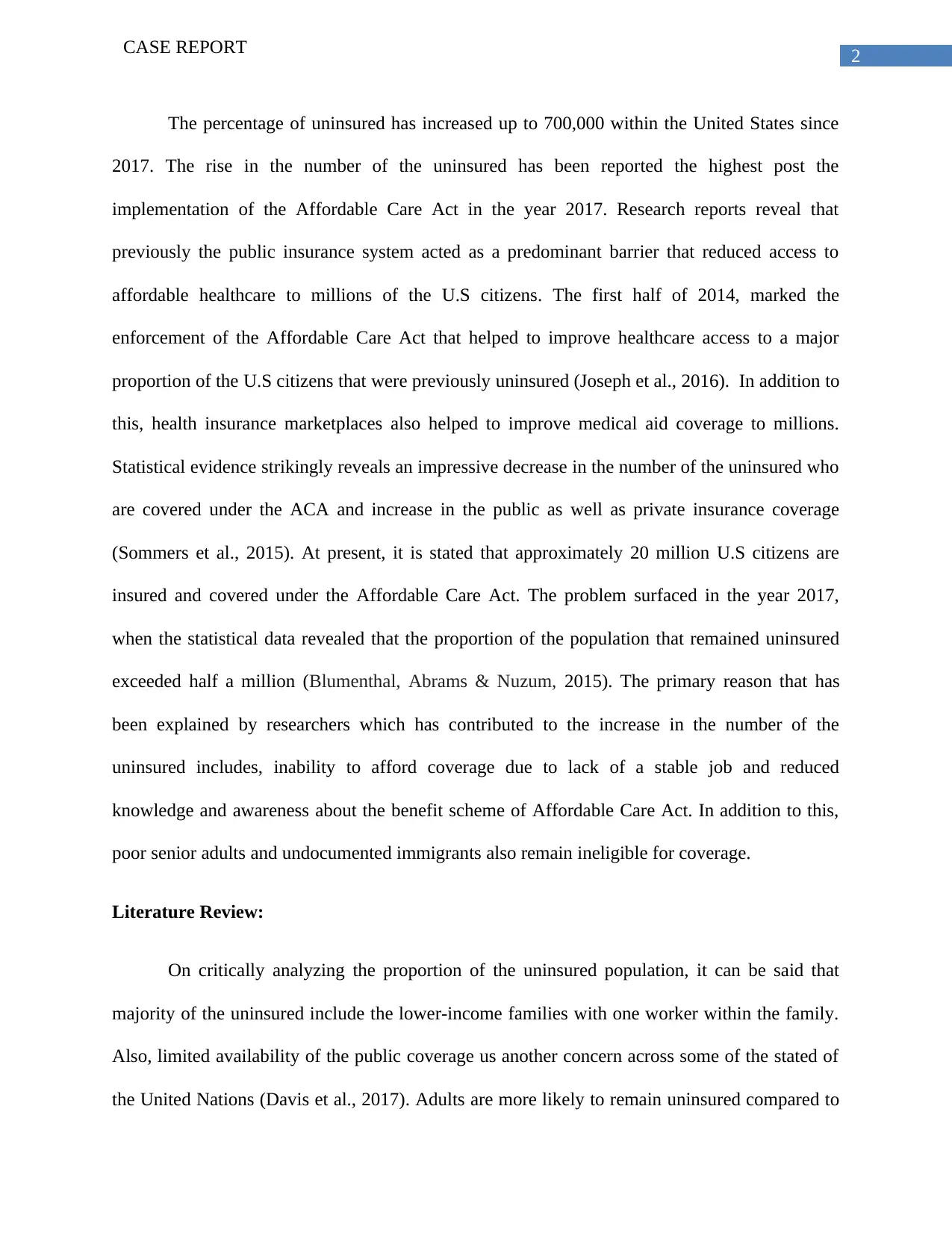
2CASE REPORT
The percentage of uninsured has increased up to 700,000 within the United States since
2017. The rise in the number of the uninsured has been reported the highest post the
implementation of the Affordable Care Act in the year 2017. Research reports reveal that
previously the public insurance system acted as a predominant barrier that reduced access to
affordable healthcare to millions of the U.S citizens. The first half of 2014, marked the
enforcement of the Affordable Care Act that helped to improve healthcare access to a major
proportion of the U.S citizens that were previously uninsured (Joseph et al., 2016). In addition to
this, health insurance marketplaces also helped to improve medical aid coverage to millions.
Statistical evidence strikingly reveals an impressive decrease in the number of the uninsured who
are covered under the ACA and increase in the public as well as private insurance coverage
(Sommers et al., 2015). At present, it is stated that approximately 20 million U.S citizens are
insured and covered under the Affordable Care Act. The problem surfaced in the year 2017,
when the statistical data revealed that the proportion of the population that remained uninsured
exceeded half a million (Blumenthal, Abrams & Nuzum, 2015). The primary reason that has
been explained by researchers which has contributed to the increase in the number of the
uninsured includes, inability to afford coverage due to lack of a stable job and reduced
knowledge and awareness about the benefit scheme of Affordable Care Act. In addition to this,
poor senior adults and undocumented immigrants also remain ineligible for coverage.
Literature Review:
On critically analyzing the proportion of the uninsured population, it can be said that
majority of the uninsured include the lower-income families with one worker within the family.
Also, limited availability of the public coverage us another concern across some of the stated of
the United Nations (Davis et al., 2017). Adults are more likely to remain uninsured compared to
The percentage of uninsured has increased up to 700,000 within the United States since
2017. The rise in the number of the uninsured has been reported the highest post the
implementation of the Affordable Care Act in the year 2017. Research reports reveal that
previously the public insurance system acted as a predominant barrier that reduced access to
affordable healthcare to millions of the U.S citizens. The first half of 2014, marked the
enforcement of the Affordable Care Act that helped to improve healthcare access to a major
proportion of the U.S citizens that were previously uninsured (Joseph et al., 2016). In addition to
this, health insurance marketplaces also helped to improve medical aid coverage to millions.
Statistical evidence strikingly reveals an impressive decrease in the number of the uninsured who
are covered under the ACA and increase in the public as well as private insurance coverage
(Sommers et al., 2015). At present, it is stated that approximately 20 million U.S citizens are
insured and covered under the Affordable Care Act. The problem surfaced in the year 2017,
when the statistical data revealed that the proportion of the population that remained uninsured
exceeded half a million (Blumenthal, Abrams & Nuzum, 2015). The primary reason that has
been explained by researchers which has contributed to the increase in the number of the
uninsured includes, inability to afford coverage due to lack of a stable job and reduced
knowledge and awareness about the benefit scheme of Affordable Care Act. In addition to this,
poor senior adults and undocumented immigrants also remain ineligible for coverage.
Literature Review:
On critically analyzing the proportion of the uninsured population, it can be said that
majority of the uninsured include the lower-income families with one worker within the family.
Also, limited availability of the public coverage us another concern across some of the stated of
the United Nations (Davis et al., 2017). Adults are more likely to remain uninsured compared to
⊘ This is a preview!⊘
Do you want full access?
Subscribe today to unlock all pages.

Trusted by 1+ million students worldwide
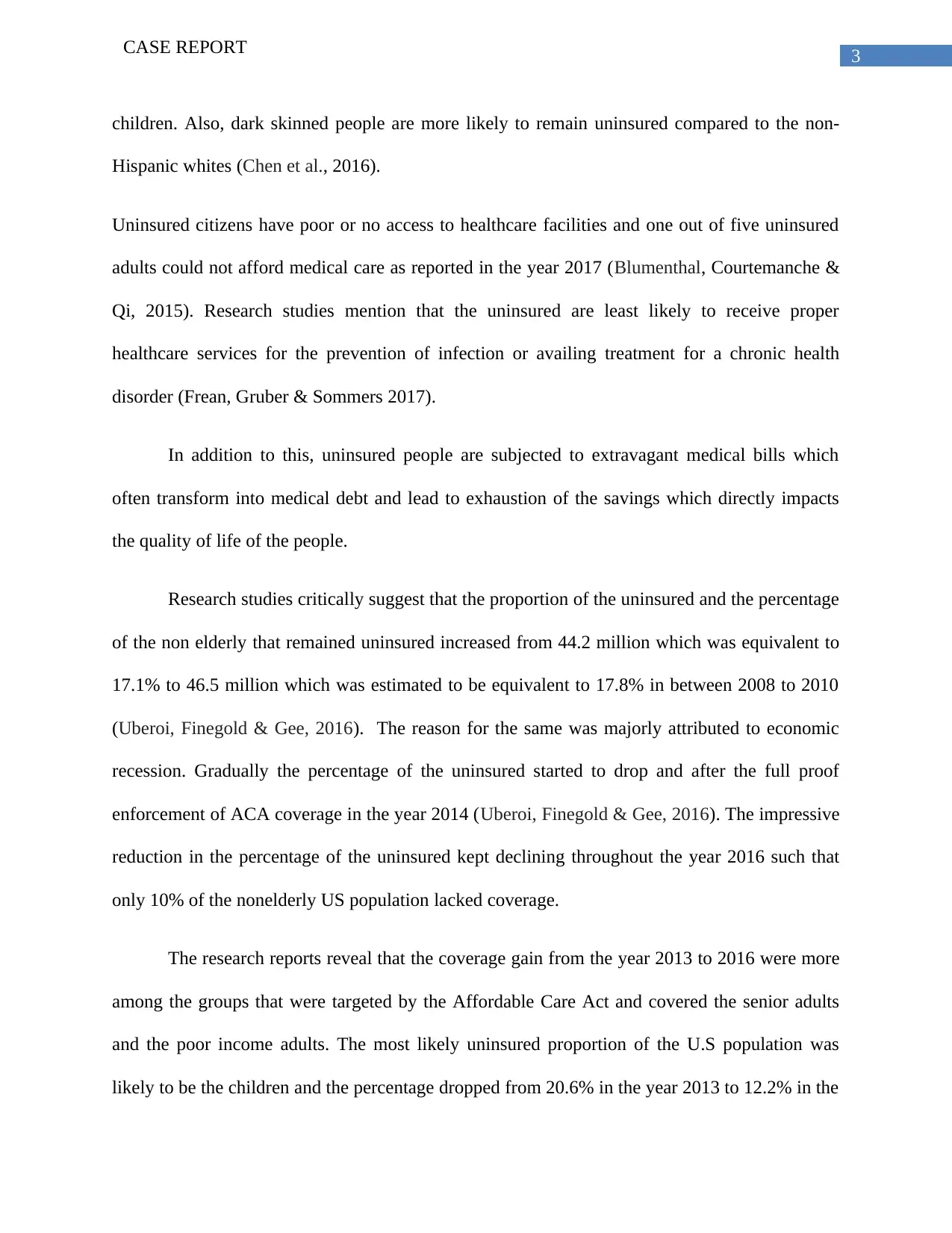
3CASE REPORT
children. Also, dark skinned people are more likely to remain uninsured compared to the non-
Hispanic whites (Chen et al., 2016).
Uninsured citizens have poor or no access to healthcare facilities and one out of five uninsured
adults could not afford medical care as reported in the year 2017 (Blumenthal, Courtemanche &
Qi, 2015). Research studies mention that the uninsured are least likely to receive proper
healthcare services for the prevention of infection or availing treatment for a chronic health
disorder (Frean, Gruber & Sommers 2017).
In addition to this, uninsured people are subjected to extravagant medical bills which
often transform into medical debt and lead to exhaustion of the savings which directly impacts
the quality of life of the people.
Research studies critically suggest that the proportion of the uninsured and the percentage
of the non elderly that remained uninsured increased from 44.2 million which was equivalent to
17.1% to 46.5 million which was estimated to be equivalent to 17.8% in between 2008 to 2010
(Uberoi, Finegold & Gee, 2016). The reason for the same was majorly attributed to economic
recession. Gradually the percentage of the uninsured started to drop and after the full proof
enforcement of ACA coverage in the year 2014 (Uberoi, Finegold & Gee, 2016). The impressive
reduction in the percentage of the uninsured kept declining throughout the year 2016 such that
only 10% of the nonelderly US population lacked coverage.
The research reports reveal that the coverage gain from the year 2013 to 2016 were more
among the groups that were targeted by the Affordable Care Act and covered the senior adults
and the poor income adults. The most likely uninsured proportion of the U.S population was
likely to be the children and the percentage dropped from 20.6% in the year 2013 to 12.2% in the
children. Also, dark skinned people are more likely to remain uninsured compared to the non-
Hispanic whites (Chen et al., 2016).
Uninsured citizens have poor or no access to healthcare facilities and one out of five uninsured
adults could not afford medical care as reported in the year 2017 (Blumenthal, Courtemanche &
Qi, 2015). Research studies mention that the uninsured are least likely to receive proper
healthcare services for the prevention of infection or availing treatment for a chronic health
disorder (Frean, Gruber & Sommers 2017).
In addition to this, uninsured people are subjected to extravagant medical bills which
often transform into medical debt and lead to exhaustion of the savings which directly impacts
the quality of life of the people.
Research studies critically suggest that the proportion of the uninsured and the percentage
of the non elderly that remained uninsured increased from 44.2 million which was equivalent to
17.1% to 46.5 million which was estimated to be equivalent to 17.8% in between 2008 to 2010
(Uberoi, Finegold & Gee, 2016). The reason for the same was majorly attributed to economic
recession. Gradually the percentage of the uninsured started to drop and after the full proof
enforcement of ACA coverage in the year 2014 (Uberoi, Finegold & Gee, 2016). The impressive
reduction in the percentage of the uninsured kept declining throughout the year 2016 such that
only 10% of the nonelderly US population lacked coverage.
The research reports reveal that the coverage gain from the year 2013 to 2016 were more
among the groups that were targeted by the Affordable Care Act and covered the senior adults
and the poor income adults. The most likely uninsured proportion of the U.S population was
likely to be the children and the percentage dropped from 20.6% in the year 2013 to 12.2% in the
Paraphrase This Document
Need a fresh take? Get an instant paraphrase of this document with our AI Paraphraser
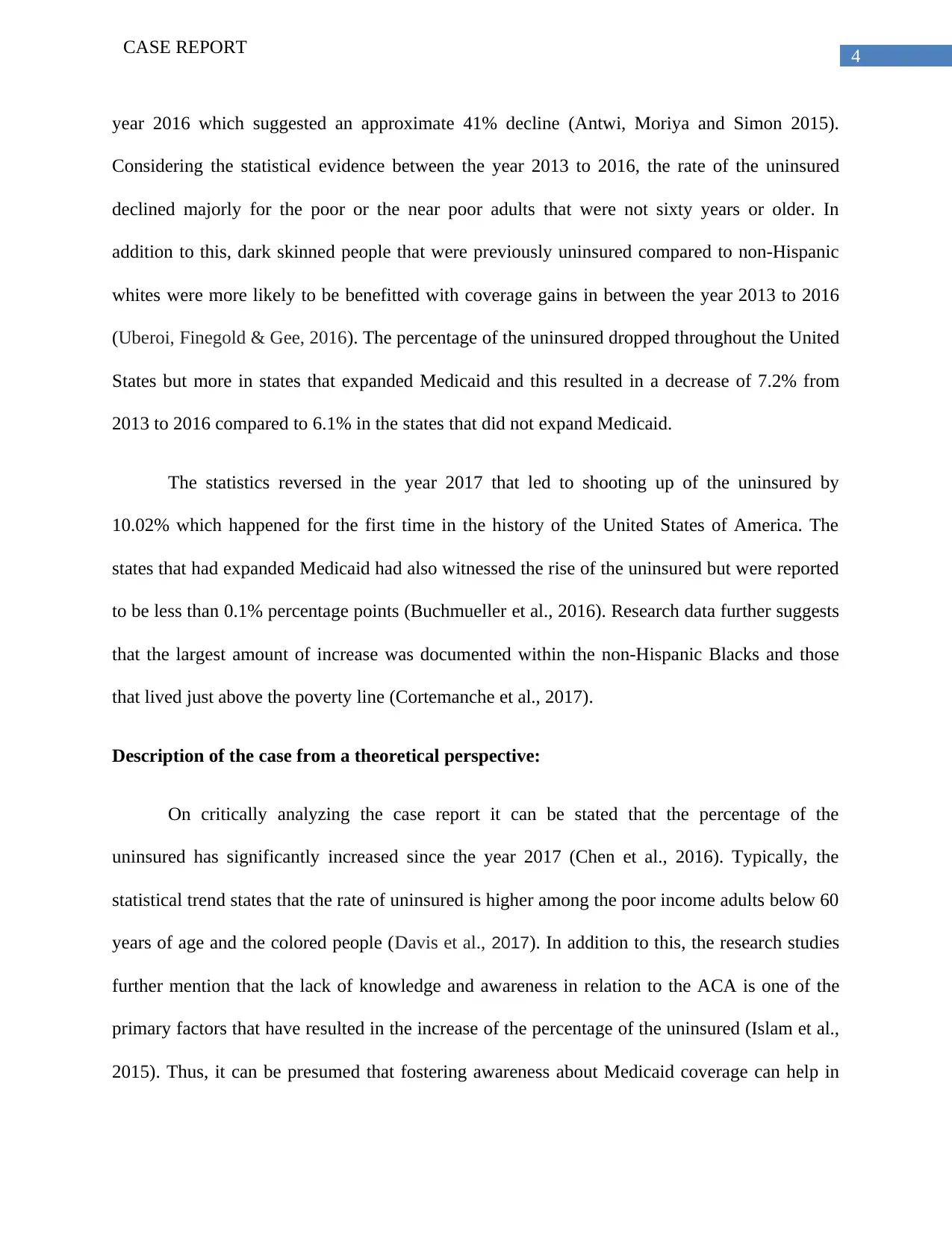
4CASE REPORT
year 2016 which suggested an approximate 41% decline (Antwi, Moriya and Simon 2015).
Considering the statistical evidence between the year 2013 to 2016, the rate of the uninsured
declined majorly for the poor or the near poor adults that were not sixty years or older. In
addition to this, dark skinned people that were previously uninsured compared to non-Hispanic
whites were more likely to be benefitted with coverage gains in between the year 2013 to 2016
(Uberoi, Finegold & Gee, 2016). The percentage of the uninsured dropped throughout the United
States but more in states that expanded Medicaid and this resulted in a decrease of 7.2% from
2013 to 2016 compared to 6.1% in the states that did not expand Medicaid.
The statistics reversed in the year 2017 that led to shooting up of the uninsured by
10.02% which happened for the first time in the history of the United States of America. The
states that had expanded Medicaid had also witnessed the rise of the uninsured but were reported
to be less than 0.1% percentage points (Buchmueller et al., 2016). Research data further suggests
that the largest amount of increase was documented within the non-Hispanic Blacks and those
that lived just above the poverty line (Cortemanche et al., 2017).
Description of the case from a theoretical perspective:
On critically analyzing the case report it can be stated that the percentage of the
uninsured has significantly increased since the year 2017 (Chen et al., 2016). Typically, the
statistical trend states that the rate of uninsured is higher among the poor income adults below 60
years of age and the colored people (Davis et al., 2017). In addition to this, the research studies
further mention that the lack of knowledge and awareness in relation to the ACA is one of the
primary factors that have resulted in the increase of the percentage of the uninsured (Islam et al.,
2015). Thus, it can be presumed that fostering awareness about Medicaid coverage can help in
year 2016 which suggested an approximate 41% decline (Antwi, Moriya and Simon 2015).
Considering the statistical evidence between the year 2013 to 2016, the rate of the uninsured
declined majorly for the poor or the near poor adults that were not sixty years or older. In
addition to this, dark skinned people that were previously uninsured compared to non-Hispanic
whites were more likely to be benefitted with coverage gains in between the year 2013 to 2016
(Uberoi, Finegold & Gee, 2016). The percentage of the uninsured dropped throughout the United
States but more in states that expanded Medicaid and this resulted in a decrease of 7.2% from
2013 to 2016 compared to 6.1% in the states that did not expand Medicaid.
The statistics reversed in the year 2017 that led to shooting up of the uninsured by
10.02% which happened for the first time in the history of the United States of America. The
states that had expanded Medicaid had also witnessed the rise of the uninsured but were reported
to be less than 0.1% percentage points (Buchmueller et al., 2016). Research data further suggests
that the largest amount of increase was documented within the non-Hispanic Blacks and those
that lived just above the poverty line (Cortemanche et al., 2017).
Description of the case from a theoretical perspective:
On critically analyzing the case report it can be stated that the percentage of the
uninsured has significantly increased since the year 2017 (Chen et al., 2016). Typically, the
statistical trend states that the rate of uninsured is higher among the poor income adults below 60
years of age and the colored people (Davis et al., 2017). In addition to this, the research studies
further mention that the lack of knowledge and awareness in relation to the ACA is one of the
primary factors that have resulted in the increase of the percentage of the uninsured (Islam et al.,
2015). Thus, it can be presumed that fostering awareness about Medicaid coverage can help in
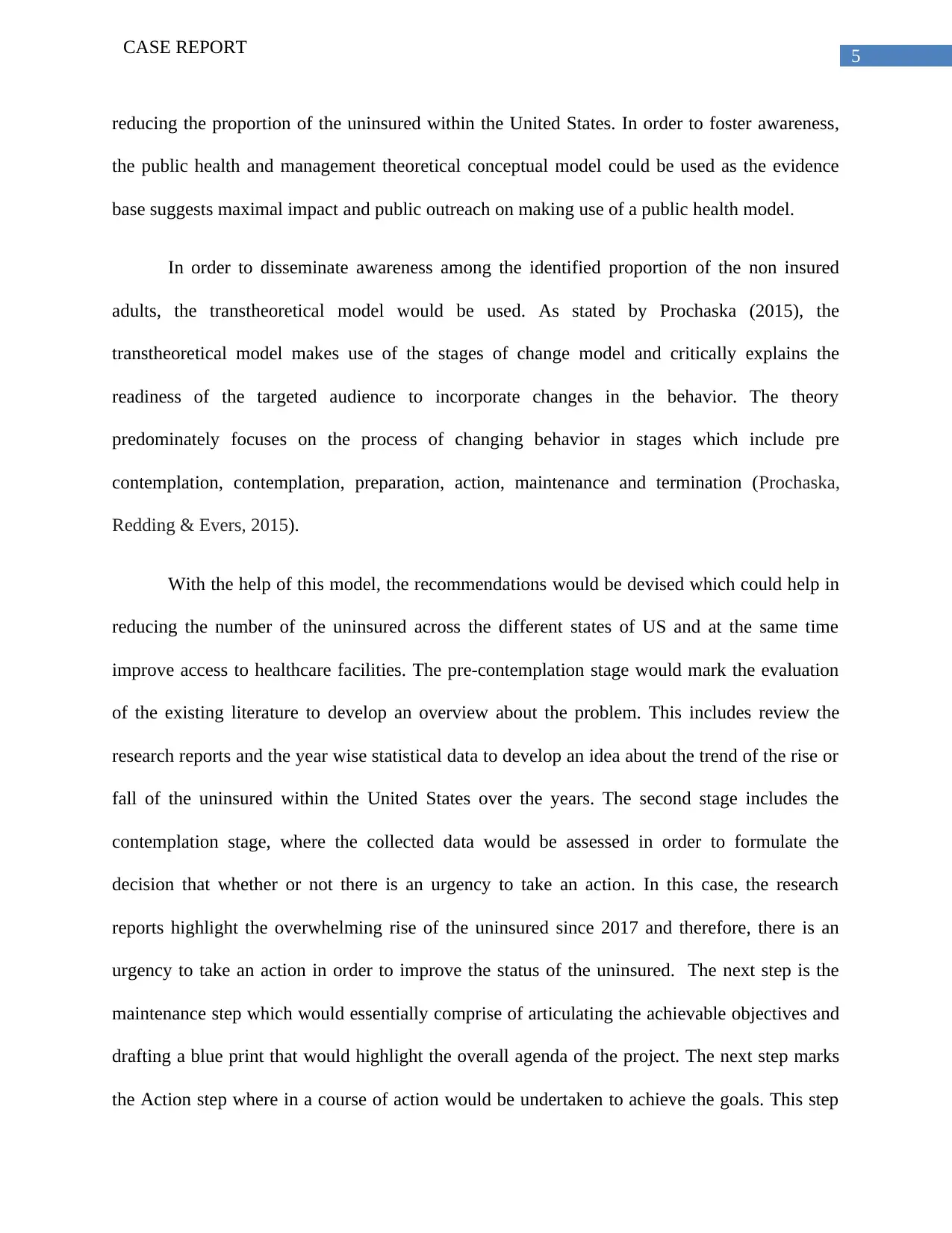
5CASE REPORT
reducing the proportion of the uninsured within the United States. In order to foster awareness,
the public health and management theoretical conceptual model could be used as the evidence
base suggests maximal impact and public outreach on making use of a public health model.
In order to disseminate awareness among the identified proportion of the non insured
adults, the transtheoretical model would be used. As stated by Prochaska (2015), the
transtheoretical model makes use of the stages of change model and critically explains the
readiness of the targeted audience to incorporate changes in the behavior. The theory
predominately focuses on the process of changing behavior in stages which include pre
contemplation, contemplation, preparation, action, maintenance and termination (Prochaska,
Redding & Evers, 2015).
With the help of this model, the recommendations would be devised which could help in
reducing the number of the uninsured across the different states of US and at the same time
improve access to healthcare facilities. The pre-contemplation stage would mark the evaluation
of the existing literature to develop an overview about the problem. This includes review the
research reports and the year wise statistical data to develop an idea about the trend of the rise or
fall of the uninsured within the United States over the years. The second stage includes the
contemplation stage, where the collected data would be assessed in order to formulate the
decision that whether or not there is an urgency to take an action. In this case, the research
reports highlight the overwhelming rise of the uninsured since 2017 and therefore, there is an
urgency to take an action in order to improve the status of the uninsured. The next step is the
maintenance step which would essentially comprise of articulating the achievable objectives and
drafting a blue print that would highlight the overall agenda of the project. The next step marks
the Action step where in a course of action would be undertaken to achieve the goals. This step
reducing the proportion of the uninsured within the United States. In order to foster awareness,
the public health and management theoretical conceptual model could be used as the evidence
base suggests maximal impact and public outreach on making use of a public health model.
In order to disseminate awareness among the identified proportion of the non insured
adults, the transtheoretical model would be used. As stated by Prochaska (2015), the
transtheoretical model makes use of the stages of change model and critically explains the
readiness of the targeted audience to incorporate changes in the behavior. The theory
predominately focuses on the process of changing behavior in stages which include pre
contemplation, contemplation, preparation, action, maintenance and termination (Prochaska,
Redding & Evers, 2015).
With the help of this model, the recommendations would be devised which could help in
reducing the number of the uninsured across the different states of US and at the same time
improve access to healthcare facilities. The pre-contemplation stage would mark the evaluation
of the existing literature to develop an overview about the problem. This includes review the
research reports and the year wise statistical data to develop an idea about the trend of the rise or
fall of the uninsured within the United States over the years. The second stage includes the
contemplation stage, where the collected data would be assessed in order to formulate the
decision that whether or not there is an urgency to take an action. In this case, the research
reports highlight the overwhelming rise of the uninsured since 2017 and therefore, there is an
urgency to take an action in order to improve the status of the uninsured. The next step is the
maintenance step which would essentially comprise of articulating the achievable objectives and
drafting a blue print that would highlight the overall agenda of the project. The next step marks
the Action step where in a course of action would be undertaken to achieve the goals. This step
⊘ This is a preview!⊘
Do you want full access?
Subscribe today to unlock all pages.

Trusted by 1+ million students worldwide
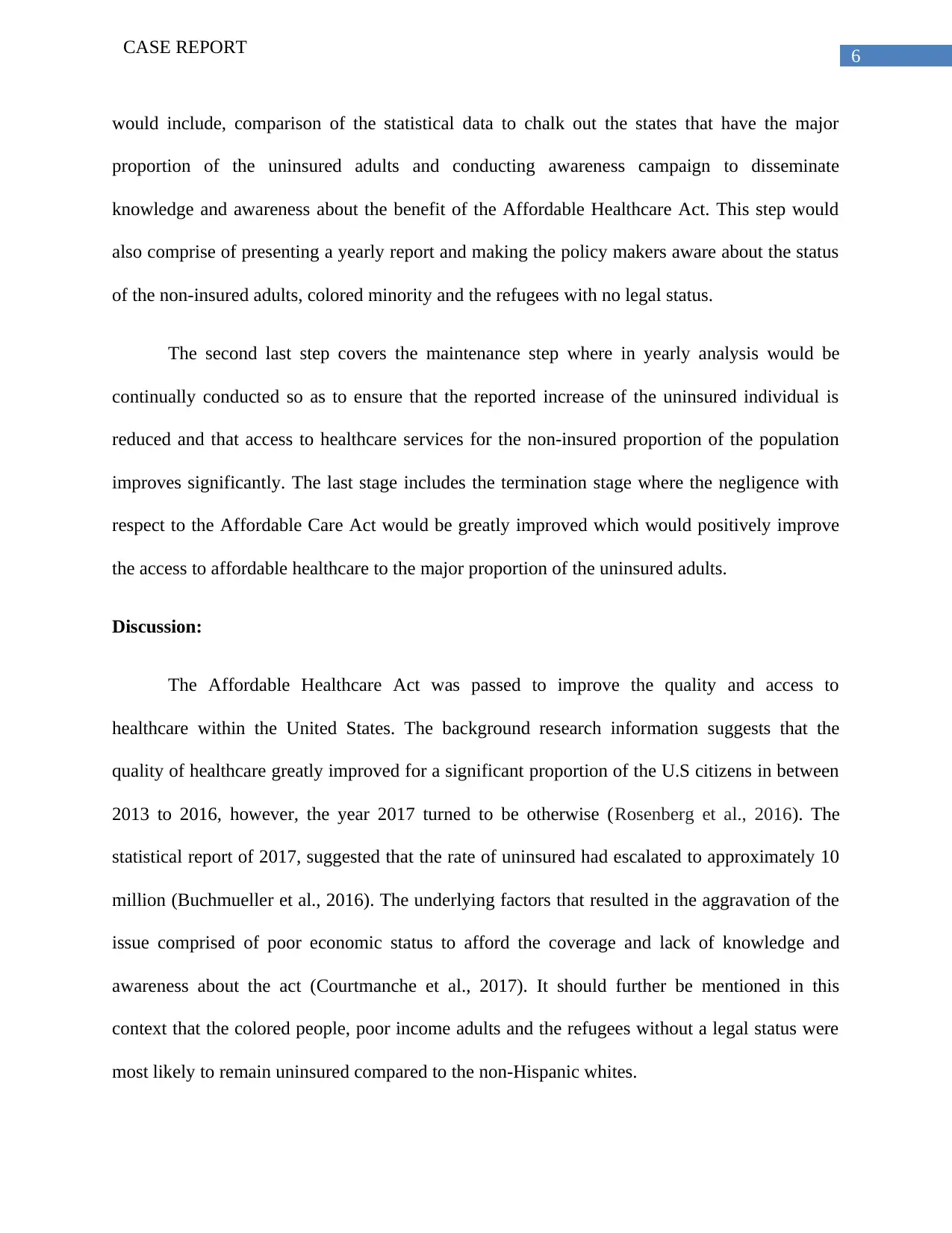
6CASE REPORT
would include, comparison of the statistical data to chalk out the states that have the major
proportion of the uninsured adults and conducting awareness campaign to disseminate
knowledge and awareness about the benefit of the Affordable Healthcare Act. This step would
also comprise of presenting a yearly report and making the policy makers aware about the status
of the non-insured adults, colored minority and the refugees with no legal status.
The second last step covers the maintenance step where in yearly analysis would be
continually conducted so as to ensure that the reported increase of the uninsured individual is
reduced and that access to healthcare services for the non-insured proportion of the population
improves significantly. The last stage includes the termination stage where the negligence with
respect to the Affordable Care Act would be greatly improved which would positively improve
the access to affordable healthcare to the major proportion of the uninsured adults.
Discussion:
The Affordable Healthcare Act was passed to improve the quality and access to
healthcare within the United States. The background research information suggests that the
quality of healthcare greatly improved for a significant proportion of the U.S citizens in between
2013 to 2016, however, the year 2017 turned to be otherwise (Rosenberg et al., 2016). The
statistical report of 2017, suggested that the rate of uninsured had escalated to approximately 10
million (Buchmueller et al., 2016). The underlying factors that resulted in the aggravation of the
issue comprised of poor economic status to afford the coverage and lack of knowledge and
awareness about the act (Courtmanche et al., 2017). It should further be mentioned in this
context that the colored people, poor income adults and the refugees without a legal status were
most likely to remain uninsured compared to the non-Hispanic whites.
would include, comparison of the statistical data to chalk out the states that have the major
proportion of the uninsured adults and conducting awareness campaign to disseminate
knowledge and awareness about the benefit of the Affordable Healthcare Act. This step would
also comprise of presenting a yearly report and making the policy makers aware about the status
of the non-insured adults, colored minority and the refugees with no legal status.
The second last step covers the maintenance step where in yearly analysis would be
continually conducted so as to ensure that the reported increase of the uninsured individual is
reduced and that access to healthcare services for the non-insured proportion of the population
improves significantly. The last stage includes the termination stage where the negligence with
respect to the Affordable Care Act would be greatly improved which would positively improve
the access to affordable healthcare to the major proportion of the uninsured adults.
Discussion:
The Affordable Healthcare Act was passed to improve the quality and access to
healthcare within the United States. The background research information suggests that the
quality of healthcare greatly improved for a significant proportion of the U.S citizens in between
2013 to 2016, however, the year 2017 turned to be otherwise (Rosenberg et al., 2016). The
statistical report of 2017, suggested that the rate of uninsured had escalated to approximately 10
million (Buchmueller et al., 2016). The underlying factors that resulted in the aggravation of the
issue comprised of poor economic status to afford the coverage and lack of knowledge and
awareness about the act (Courtmanche et al., 2017). It should further be mentioned in this
context that the colored people, poor income adults and the refugees without a legal status were
most likely to remain uninsured compared to the non-Hispanic whites.
Paraphrase This Document
Need a fresh take? Get an instant paraphrase of this document with our AI Paraphraser
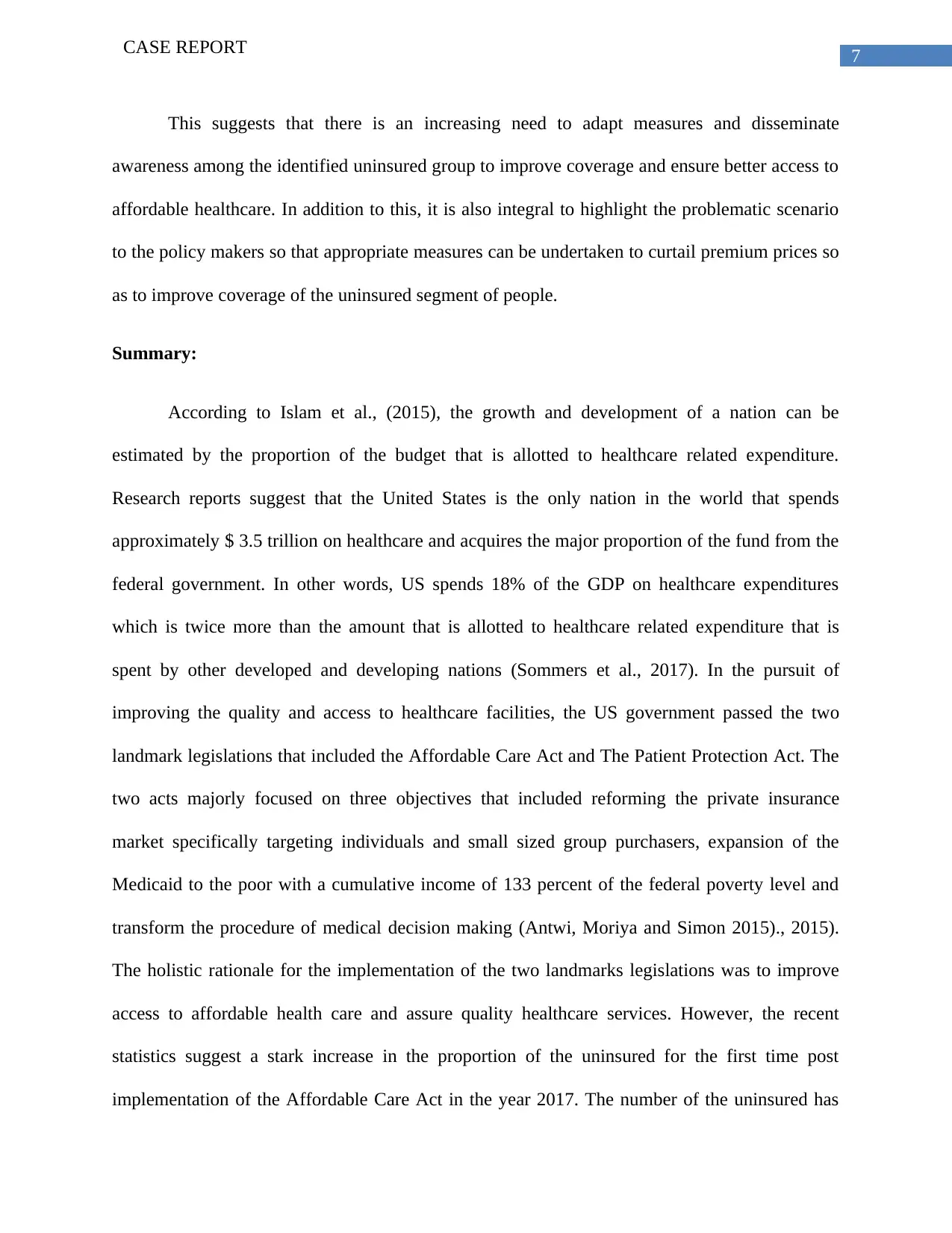
7CASE REPORT
This suggests that there is an increasing need to adapt measures and disseminate
awareness among the identified uninsured group to improve coverage and ensure better access to
affordable healthcare. In addition to this, it is also integral to highlight the problematic scenario
to the policy makers so that appropriate measures can be undertaken to curtail premium prices so
as to improve coverage of the uninsured segment of people.
Summary:
According to Islam et al., (2015), the growth and development of a nation can be
estimated by the proportion of the budget that is allotted to healthcare related expenditure.
Research reports suggest that the United States is the only nation in the world that spends
approximately $ 3.5 trillion on healthcare and acquires the major proportion of the fund from the
federal government. In other words, US spends 18% of the GDP on healthcare expenditures
which is twice more than the amount that is allotted to healthcare related expenditure that is
spent by other developed and developing nations (Sommers et al., 2017). In the pursuit of
improving the quality and access to healthcare facilities, the US government passed the two
landmark legislations that included the Affordable Care Act and The Patient Protection Act. The
two acts majorly focused on three objectives that included reforming the private insurance
market specifically targeting individuals and small sized group purchasers, expansion of the
Medicaid to the poor with a cumulative income of 133 percent of the federal poverty level and
transform the procedure of medical decision making (Antwi, Moriya and Simon 2015)., 2015).
The holistic rationale for the implementation of the two landmarks legislations was to improve
access to affordable health care and assure quality healthcare services. However, the recent
statistics suggest a stark increase in the proportion of the uninsured for the first time post
implementation of the Affordable Care Act in the year 2017. The number of the uninsured has
This suggests that there is an increasing need to adapt measures and disseminate
awareness among the identified uninsured group to improve coverage and ensure better access to
affordable healthcare. In addition to this, it is also integral to highlight the problematic scenario
to the policy makers so that appropriate measures can be undertaken to curtail premium prices so
as to improve coverage of the uninsured segment of people.
Summary:
According to Islam et al., (2015), the growth and development of a nation can be
estimated by the proportion of the budget that is allotted to healthcare related expenditure.
Research reports suggest that the United States is the only nation in the world that spends
approximately $ 3.5 trillion on healthcare and acquires the major proportion of the fund from the
federal government. In other words, US spends 18% of the GDP on healthcare expenditures
which is twice more than the amount that is allotted to healthcare related expenditure that is
spent by other developed and developing nations (Sommers et al., 2017). In the pursuit of
improving the quality and access to healthcare facilities, the US government passed the two
landmark legislations that included the Affordable Care Act and The Patient Protection Act. The
two acts majorly focused on three objectives that included reforming the private insurance
market specifically targeting individuals and small sized group purchasers, expansion of the
Medicaid to the poor with a cumulative income of 133 percent of the federal poverty level and
transform the procedure of medical decision making (Antwi, Moriya and Simon 2015)., 2015).
The holistic rationale for the implementation of the two landmarks legislations was to improve
access to affordable health care and assure quality healthcare services. However, the recent
statistics suggest a stark increase in the proportion of the uninsured for the first time post
implementation of the Affordable Care Act in the year 2017. The number of the uninsured has
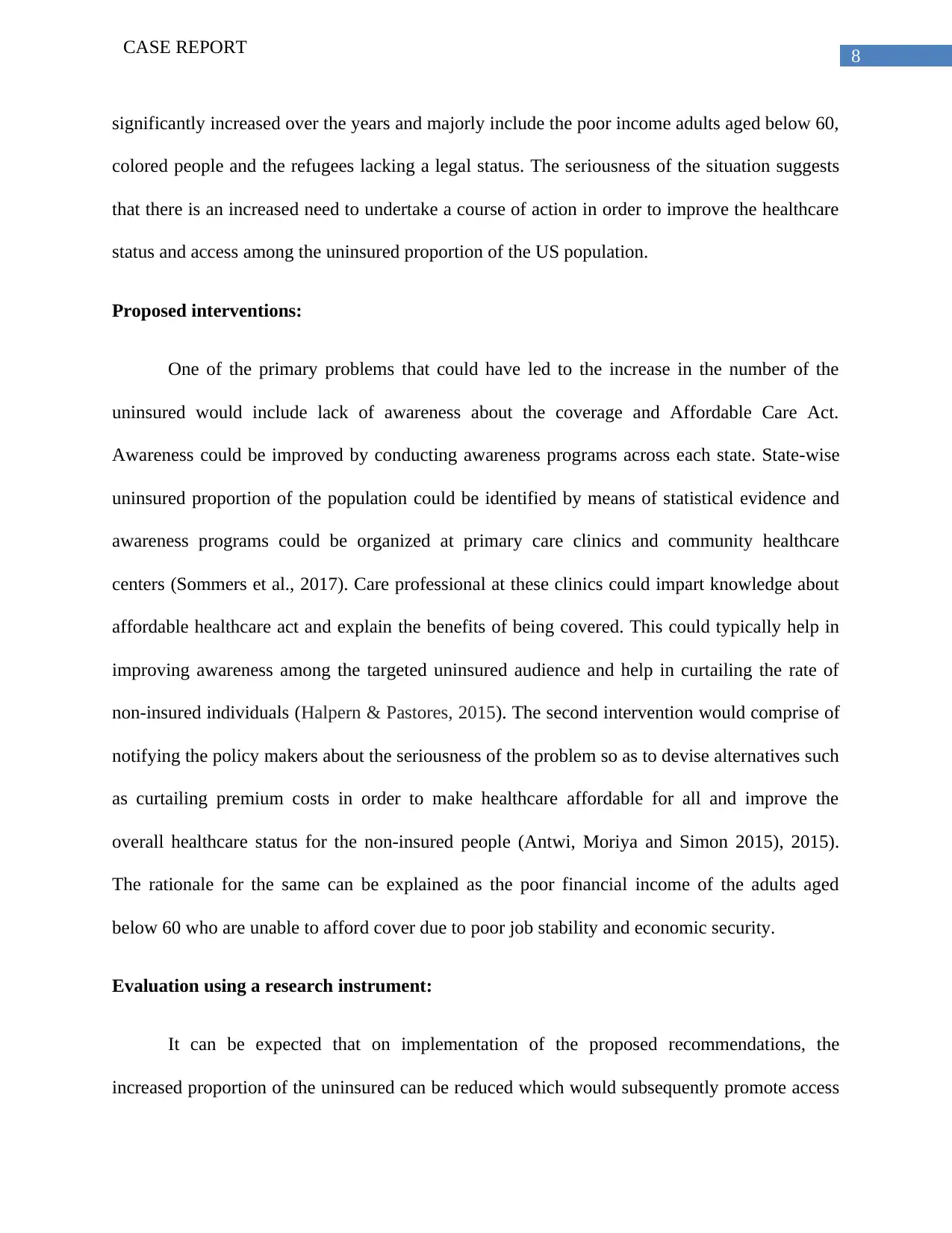
8CASE REPORT
significantly increased over the years and majorly include the poor income adults aged below 60,
colored people and the refugees lacking a legal status. The seriousness of the situation suggests
that there is an increased need to undertake a course of action in order to improve the healthcare
status and access among the uninsured proportion of the US population.
Proposed interventions:
One of the primary problems that could have led to the increase in the number of the
uninsured would include lack of awareness about the coverage and Affordable Care Act.
Awareness could be improved by conducting awareness programs across each state. State-wise
uninsured proportion of the population could be identified by means of statistical evidence and
awareness programs could be organized at primary care clinics and community healthcare
centers (Sommers et al., 2017). Care professional at these clinics could impart knowledge about
affordable healthcare act and explain the benefits of being covered. This could typically help in
improving awareness among the targeted uninsured audience and help in curtailing the rate of
non-insured individuals (Halpern & Pastores, 2015). The second intervention would comprise of
notifying the policy makers about the seriousness of the problem so as to devise alternatives such
as curtailing premium costs in order to make healthcare affordable for all and improve the
overall healthcare status for the non-insured people (Antwi, Moriya and Simon 2015), 2015).
The rationale for the same can be explained as the poor financial income of the adults aged
below 60 who are unable to afford cover due to poor job stability and economic security.
Evaluation using a research instrument:
It can be expected that on implementation of the proposed recommendations, the
increased proportion of the uninsured can be reduced which would subsequently promote access
significantly increased over the years and majorly include the poor income adults aged below 60,
colored people and the refugees lacking a legal status. The seriousness of the situation suggests
that there is an increased need to undertake a course of action in order to improve the healthcare
status and access among the uninsured proportion of the US population.
Proposed interventions:
One of the primary problems that could have led to the increase in the number of the
uninsured would include lack of awareness about the coverage and Affordable Care Act.
Awareness could be improved by conducting awareness programs across each state. State-wise
uninsured proportion of the population could be identified by means of statistical evidence and
awareness programs could be organized at primary care clinics and community healthcare
centers (Sommers et al., 2017). Care professional at these clinics could impart knowledge about
affordable healthcare act and explain the benefits of being covered. This could typically help in
improving awareness among the targeted uninsured audience and help in curtailing the rate of
non-insured individuals (Halpern & Pastores, 2015). The second intervention would comprise of
notifying the policy makers about the seriousness of the problem so as to devise alternatives such
as curtailing premium costs in order to make healthcare affordable for all and improve the
overall healthcare status for the non-insured people (Antwi, Moriya and Simon 2015), 2015).
The rationale for the same can be explained as the poor financial income of the adults aged
below 60 who are unable to afford cover due to poor job stability and economic security.
Evaluation using a research instrument:
It can be expected that on implementation of the proposed recommendations, the
increased proportion of the uninsured can be reduced which would subsequently promote access
⊘ This is a preview!⊘
Do you want full access?
Subscribe today to unlock all pages.

Trusted by 1+ million students worldwide
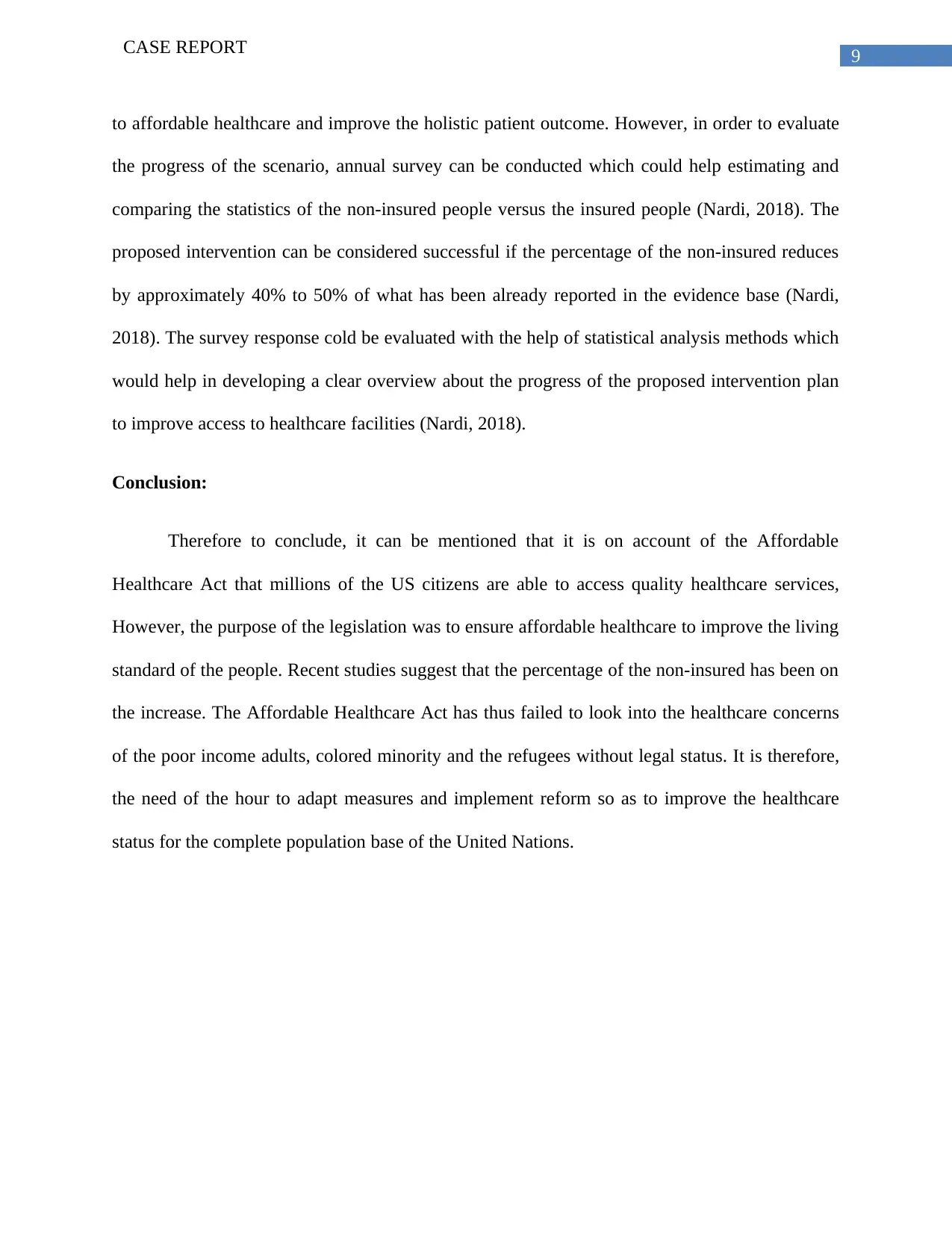
9CASE REPORT
to affordable healthcare and improve the holistic patient outcome. However, in order to evaluate
the progress of the scenario, annual survey can be conducted which could help estimating and
comparing the statistics of the non-insured people versus the insured people (Nardi, 2018). The
proposed intervention can be considered successful if the percentage of the non-insured reduces
by approximately 40% to 50% of what has been already reported in the evidence base (Nardi,
2018). The survey response cold be evaluated with the help of statistical analysis methods which
would help in developing a clear overview about the progress of the proposed intervention plan
to improve access to healthcare facilities (Nardi, 2018).
Conclusion:
Therefore to conclude, it can be mentioned that it is on account of the Affordable
Healthcare Act that millions of the US citizens are able to access quality healthcare services,
However, the purpose of the legislation was to ensure affordable healthcare to improve the living
standard of the people. Recent studies suggest that the percentage of the non-insured has been on
the increase. The Affordable Healthcare Act has thus failed to look into the healthcare concerns
of the poor income adults, colored minority and the refugees without legal status. It is therefore,
the need of the hour to adapt measures and implement reform so as to improve the healthcare
status for the complete population base of the United Nations.
to affordable healthcare and improve the holistic patient outcome. However, in order to evaluate
the progress of the scenario, annual survey can be conducted which could help estimating and
comparing the statistics of the non-insured people versus the insured people (Nardi, 2018). The
proposed intervention can be considered successful if the percentage of the non-insured reduces
by approximately 40% to 50% of what has been already reported in the evidence base (Nardi,
2018). The survey response cold be evaluated with the help of statistical analysis methods which
would help in developing a clear overview about the progress of the proposed intervention plan
to improve access to healthcare facilities (Nardi, 2018).
Conclusion:
Therefore to conclude, it can be mentioned that it is on account of the Affordable
Healthcare Act that millions of the US citizens are able to access quality healthcare services,
However, the purpose of the legislation was to ensure affordable healthcare to improve the living
standard of the people. Recent studies suggest that the percentage of the non-insured has been on
the increase. The Affordable Healthcare Act has thus failed to look into the healthcare concerns
of the poor income adults, colored minority and the refugees without legal status. It is therefore,
the need of the hour to adapt measures and implement reform so as to improve the healthcare
status for the complete population base of the United Nations.
Paraphrase This Document
Need a fresh take? Get an instant paraphrase of this document with our AI Paraphraser
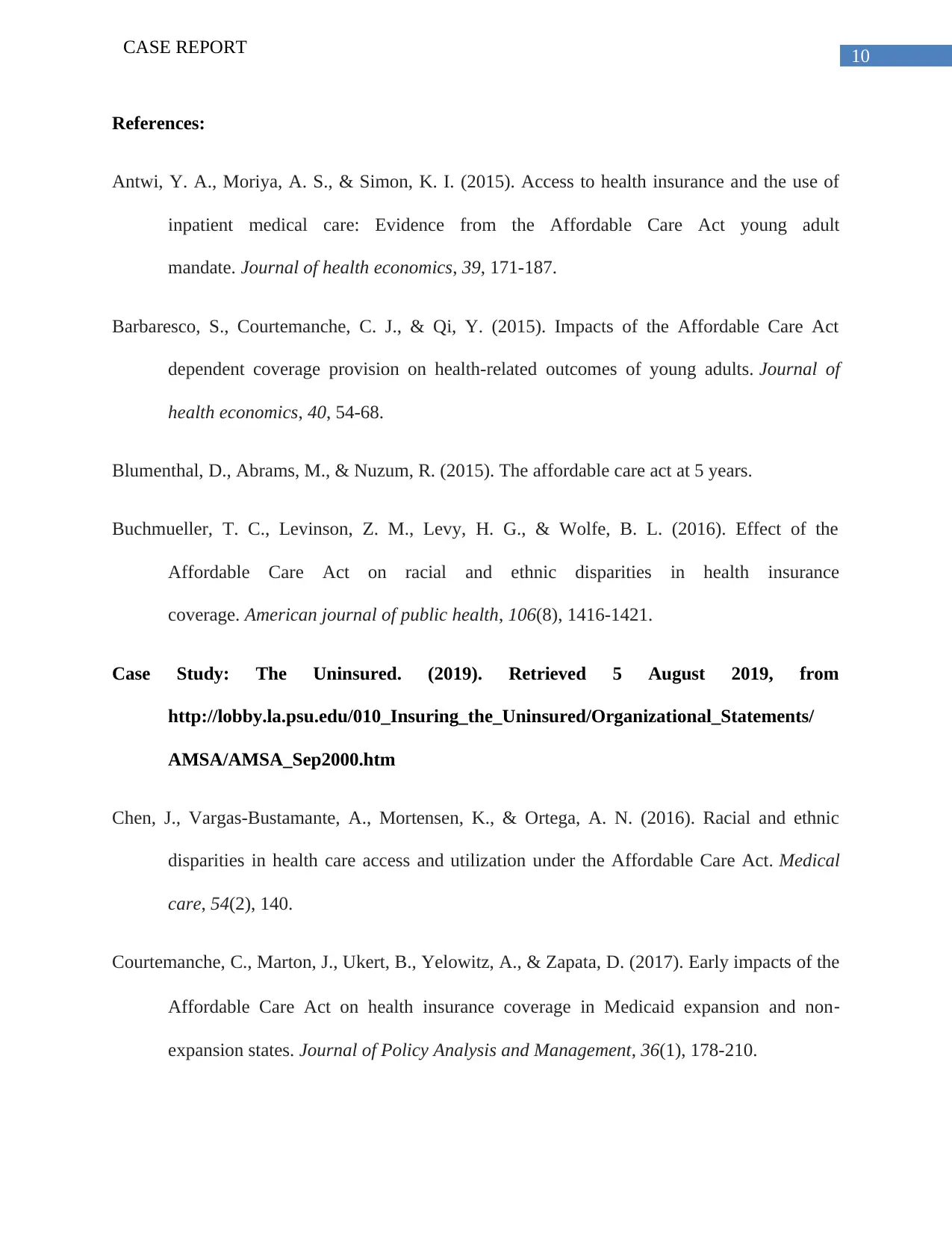
10CASE REPORT
References:
Antwi, Y. A., Moriya, A. S., & Simon, K. I. (2015). Access to health insurance and the use of
inpatient medical care: Evidence from the Affordable Care Act young adult
mandate. Journal of health economics, 39, 171-187.
Barbaresco, S., Courtemanche, C. J., & Qi, Y. (2015). Impacts of the Affordable Care Act
dependent coverage provision on health-related outcomes of young adults. Journal of
health economics, 40, 54-68.
Blumenthal, D., Abrams, M., & Nuzum, R. (2015). The affordable care act at 5 years.
Buchmueller, T. C., Levinson, Z. M., Levy, H. G., & Wolfe, B. L. (2016). Effect of the
Affordable Care Act on racial and ethnic disparities in health insurance
coverage. American journal of public health, 106(8), 1416-1421.
Case Study: The Uninsured. (2019). Retrieved 5 August 2019, from
http://lobby.la.psu.edu/010_Insuring_the_Uninsured/Organizational_Statements/
AMSA/AMSA_Sep2000.htm
Chen, J., Vargas-Bustamante, A., Mortensen, K., & Ortega, A. N. (2016). Racial and ethnic
disparities in health care access and utilization under the Affordable Care Act. Medical
care, 54(2), 140.
Courtemanche, C., Marton, J., Ukert, B., Yelowitz, A., & Zapata, D. (2017). Early impacts of the
Affordable Care Act on health insurance coverage in Medicaid expansion and non‐
expansion states. Journal of Policy Analysis and Management, 36(1), 178-210.
References:
Antwi, Y. A., Moriya, A. S., & Simon, K. I. (2015). Access to health insurance and the use of
inpatient medical care: Evidence from the Affordable Care Act young adult
mandate. Journal of health economics, 39, 171-187.
Barbaresco, S., Courtemanche, C. J., & Qi, Y. (2015). Impacts of the Affordable Care Act
dependent coverage provision on health-related outcomes of young adults. Journal of
health economics, 40, 54-68.
Blumenthal, D., Abrams, M., & Nuzum, R. (2015). The affordable care act at 5 years.
Buchmueller, T. C., Levinson, Z. M., Levy, H. G., & Wolfe, B. L. (2016). Effect of the
Affordable Care Act on racial and ethnic disparities in health insurance
coverage. American journal of public health, 106(8), 1416-1421.
Case Study: The Uninsured. (2019). Retrieved 5 August 2019, from
http://lobby.la.psu.edu/010_Insuring_the_Uninsured/Organizational_Statements/
AMSA/AMSA_Sep2000.htm
Chen, J., Vargas-Bustamante, A., Mortensen, K., & Ortega, A. N. (2016). Racial and ethnic
disparities in health care access and utilization under the Affordable Care Act. Medical
care, 54(2), 140.
Courtemanche, C., Marton, J., Ukert, B., Yelowitz, A., & Zapata, D. (2017). Early impacts of the
Affordable Care Act on health insurance coverage in Medicaid expansion and non‐
expansion states. Journal of Policy Analysis and Management, 36(1), 178-210.
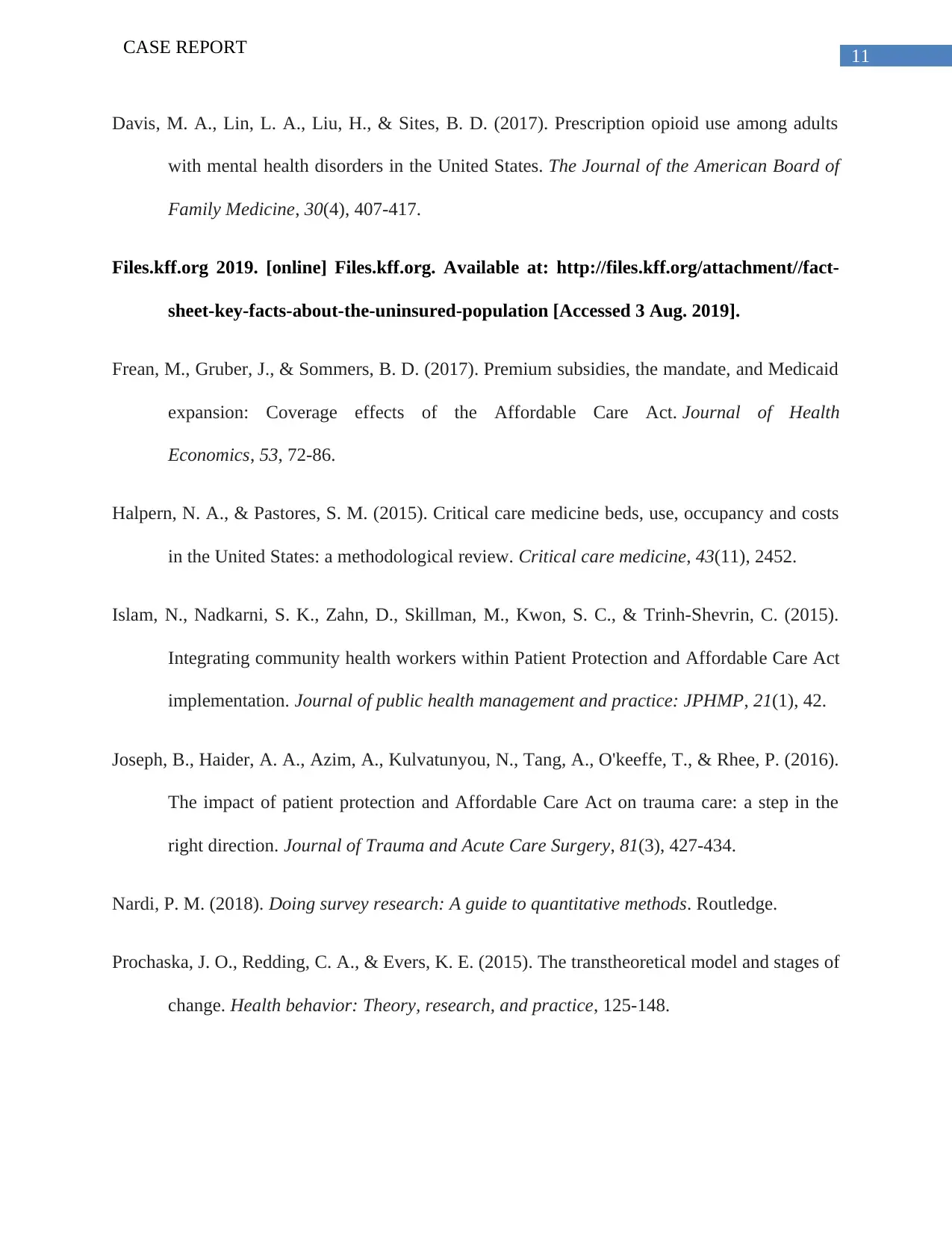
11CASE REPORT
Davis, M. A., Lin, L. A., Liu, H., & Sites, B. D. (2017). Prescription opioid use among adults
with mental health disorders in the United States. The Journal of the American Board of
Family Medicine, 30(4), 407-417.
Files.kff.org 2019. [online] Files.kff.org. Available at: http://files.kff.org/attachment//fact-
sheet-key-facts-about-the-uninsured-population [Accessed 3 Aug. 2019].
Frean, M., Gruber, J., & Sommers, B. D. (2017). Premium subsidies, the mandate, and Medicaid
expansion: Coverage effects of the Affordable Care Act. Journal of Health
Economics, 53, 72-86.
Halpern, N. A., & Pastores, S. M. (2015). Critical care medicine beds, use, occupancy and costs
in the United States: a methodological review. Critical care medicine, 43(11), 2452.
Islam, N., Nadkarni, S. K., Zahn, D., Skillman, M., Kwon, S. C., & Trinh-Shevrin, C. (2015).
Integrating community health workers within Patient Protection and Affordable Care Act
implementation. Journal of public health management and practice: JPHMP, 21(1), 42.
Joseph, B., Haider, A. A., Azim, A., Kulvatunyou, N., Tang, A., O'keeffe, T., & Rhee, P. (2016).
The impact of patient protection and Affordable Care Act on trauma care: a step in the
right direction. Journal of Trauma and Acute Care Surgery, 81(3), 427-434.
Nardi, P. M. (2018). Doing survey research: A guide to quantitative methods. Routledge.
Prochaska, J. O., Redding, C. A., & Evers, K. E. (2015). The transtheoretical model and stages of
change. Health behavior: Theory, research, and practice, 125-148.
Davis, M. A., Lin, L. A., Liu, H., & Sites, B. D. (2017). Prescription opioid use among adults
with mental health disorders in the United States. The Journal of the American Board of
Family Medicine, 30(4), 407-417.
Files.kff.org 2019. [online] Files.kff.org. Available at: http://files.kff.org/attachment//fact-
sheet-key-facts-about-the-uninsured-population [Accessed 3 Aug. 2019].
Frean, M., Gruber, J., & Sommers, B. D. (2017). Premium subsidies, the mandate, and Medicaid
expansion: Coverage effects of the Affordable Care Act. Journal of Health
Economics, 53, 72-86.
Halpern, N. A., & Pastores, S. M. (2015). Critical care medicine beds, use, occupancy and costs
in the United States: a methodological review. Critical care medicine, 43(11), 2452.
Islam, N., Nadkarni, S. K., Zahn, D., Skillman, M., Kwon, S. C., & Trinh-Shevrin, C. (2015).
Integrating community health workers within Patient Protection and Affordable Care Act
implementation. Journal of public health management and practice: JPHMP, 21(1), 42.
Joseph, B., Haider, A. A., Azim, A., Kulvatunyou, N., Tang, A., O'keeffe, T., & Rhee, P. (2016).
The impact of patient protection and Affordable Care Act on trauma care: a step in the
right direction. Journal of Trauma and Acute Care Surgery, 81(3), 427-434.
Nardi, P. M. (2018). Doing survey research: A guide to quantitative methods. Routledge.
Prochaska, J. O., Redding, C. A., & Evers, K. E. (2015). The transtheoretical model and stages of
change. Health behavior: Theory, research, and practice, 125-148.
⊘ This is a preview!⊘
Do you want full access?
Subscribe today to unlock all pages.

Trusted by 1+ million students worldwide
1 out of 13
Related Documents
Your All-in-One AI-Powered Toolkit for Academic Success.
+13062052269
info@desklib.com
Available 24*7 on WhatsApp / Email
![[object Object]](/_next/static/media/star-bottom.7253800d.svg)
Unlock your academic potential
Copyright © 2020–2025 A2Z Services. All Rights Reserved. Developed and managed by ZUCOL.




